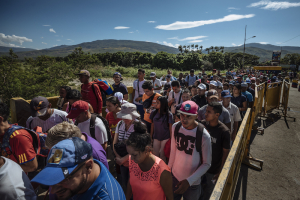Indicators in this domain assess the extent to which migrants have the same status as citizens in terms of access to basic social services such as health, education, and social security. It also describes the rights of migrants to family reunification, to work, and to residency and citizenship. The ratification of the main international conventions is also included within this domain.
Indicators in this category look at the extent to which migrants have access to certain social services such as health, education and social security. They also examine measures to ensure integration and access to work.
Indicators in this domain assess countries’ institutional, legal, and regulatory frameworks related to migration policies. Domain 2 also reviews the existence of national migration strategies that are in-line with development, as well as institutional transparency and coherence in relation to migration management. This domain also investigates the extent to which governments collect and use migration data.
Indicators in this category assess the institutional frameworks of cities for migration. This area also examines the existence of migration strategies consistent with development objectives, as well as institutional transparency and coherence in migration management.
This domain focuses on countries’ efforts to cooperate on migration-related issues with other states and with relevant non-governmental actors, including civil society organizations and the private sector. Cooperation can lead to improvements in governance by aligning and raising standards, increasing dialogue and providing structures to overcome challenges.
Indicators in this category focus on cities’ efforts to cooperate on migration issues with the national government as well as other cities and relevant non-governmental actors, including civil society organizations and the private sector.
This domain includes indicators on countries’ policies for managing the socioeconomic well-being of migrants, through aspects such as the recognition of migrants’ educational and professional qualifications, provisions regulating student migration and the existence of bilateral labour agreements between countries. Indicators equally focus on policies and strategies related to diaspora engagement and migrant remittances.
Indicators in this category assess cities’ initiatives in terms of international student mobility, access to the labour market and decent working conditions for migrant workers. Aspects related to diaspora engagement and migrant remittances are also included in this domain.
This domain studies the type and level of preparedness of countries when they are faced with mobility dimensions of crises, linked to either disasters, the environment and/or conflict. The questions are used to identify the processes in place for nationals and non-nationals both during and after disasters, including whether humanitarian assistance is equally available to migrants as it is to citizens.
Indicators in this category examine the type and level of readiness of cities to deal with aspects of mobility crises. The questions focus on the processes in place for citizens and non-citizens both during and after disasters, especially if humanitarian assistance is available for migrants and citizens.
This domain analyses countries’ approach to migration management in terms of border control and enforcement policies, admission criteria for migrants, preparedness and resilience in the case of significant and unexpected migration flows, as well as the fight against trafficking in human beings and smuggling of migrants. It also assesses efforts and incentives to help integrate returning citizens.
Indicators in this category look at the cities’ approaches to migrant safety as well as return and reintegration policies and the fight against trafficking in persons.
This country Profile describes examples of well-developed areas of The Kingdom of Cambodia (hereafter referred to as Cambodia) migration governance structures and areas with potential for further development, as evaluated through the six domains of the Migration Governance Indicators (MGI). These address migrants’ rights, a “whole-of-government” approach, partnerships, socioeconomic well-being of migrants, the mobility dimensions of crises, and safe and orderly migration.
Click the icons on the wheel to explore the key findings.
The Migration Governance Indicators (MGI) initiative is a policy-benchmarking programme led by the International Organization for Migration (IOM) and implemented with research and analysis from the Economist Intelligence Unit. Funding is provided by IOM Member States.
Migration Governance: examples of well-developed areas
- Regular migrant workers have equal access as citizens to Government-funded health care under Cambodia’s social security scheme.
- The National Social Security Fund covers pension and invalidity benefits for all regular workers, regardless of their nationality.
- The Labour Law protects foreigners against discrimination in employment on the basis of race, color, sex and religion.
Areas with potential for further development:
- Foreigners must fulfil certain specific requirements to stand for election as trade union representatives.
- Cambodians overseas cannot vote from abroad.
Migration Governance: examples of well-developed areas
- The Policy on Labour Migration highlights the vulnerabilities of migrant women, underage boys and girls, and families left behind, as well as the opportunities that labour migration presents for women.
- The National Committee for Counter Trafficking collects and analyses data, develops laws, policies and plans and coordinates efforts with other stakeholders to respond to human trafficking issues.
- The Ministry of Foreign Affairs and International Cooperation facilitates the migration of nationals for work purposes.
- The Cambodian census contains questions on migration, including on place of birth and reason for migration.
Areas with potential for further development:
- There is no government institution tasked with coordinating efforts to engage with the diaspora.
Migration Governance: examples of well-developed areas
- As a member of the Coordinated Mekong Ministerial Initiative against Trafficking, Cambodia implements the Memorandum of Understanding (MOU) on Cooperation against Trafficking in Persons in the Greater Mekong Sub-region.
- In 2003, Cambodia signed an MOU with Thailand on Cooperation in the Employment of Workers.
- Cambodia regularly participates in bilateral migration discussions with other countries, such as Myanmar and Viet Nam.
Areas with potential for further development:
- Cambodia engages with civil society organizations and the private sector on labour migration issues on an ad hoc basis.
Migration Governance: examples of well-developed areas
- Cambodia considers a migrant worker’s skills and capabilities when issuing a work permit.
- The Code of Conduct for Cambodian Private Recruitment Agencies aims to promote and protect the rights of Cambodian migrant workers during the recruitment process.
- Migrant Resource Centres provide potential Cambodian migrants with information about safe migration and access to complaint processes.
Areas with potential for further development:
- Cambodia does not have a national assessment framework for monitoring the labour market demand for immigrants or the effects of emigration on the domestic labour market.
- Cambodia has measures to promote gender equality in the labour force, but none is specifically targeted at migrants.
Migration Governance: examples of well-developed areas
- The National Strategic Development Plan sets as a policy priority the reintegration of returning migrants through skills recognition and portability of their social security entitlements.
- Cambodian embassies provide some assistance to nationals living abroad, including emergency repatriation.
Areas with potential for further development:
- The National Action Plan for Disaster Risk Reduction does not contain specific measures for migrants.
- Cambodia’s systems to provide the public with information on the evolving nature of crises do not take into consideration the specific vulnerabilities of migrants.
Migration Governance: examples of well-developed areas
- The General Department of Immigration monitors visa overstays systematically through its Foreigners Present in Cambodia System.
- The Five-year National Strategic Plan for Counter Trafficking in Persons adopts a gender-responsive approach to preventing and responding to trafficking.
- The Village–Commune Safety Policy urges community-level authorities to implement measures to eliminate trafficking of women and children in the communes in Cambodia.
Areas with potential for further development:
- There is no national training system in place for front-line border police officials.




